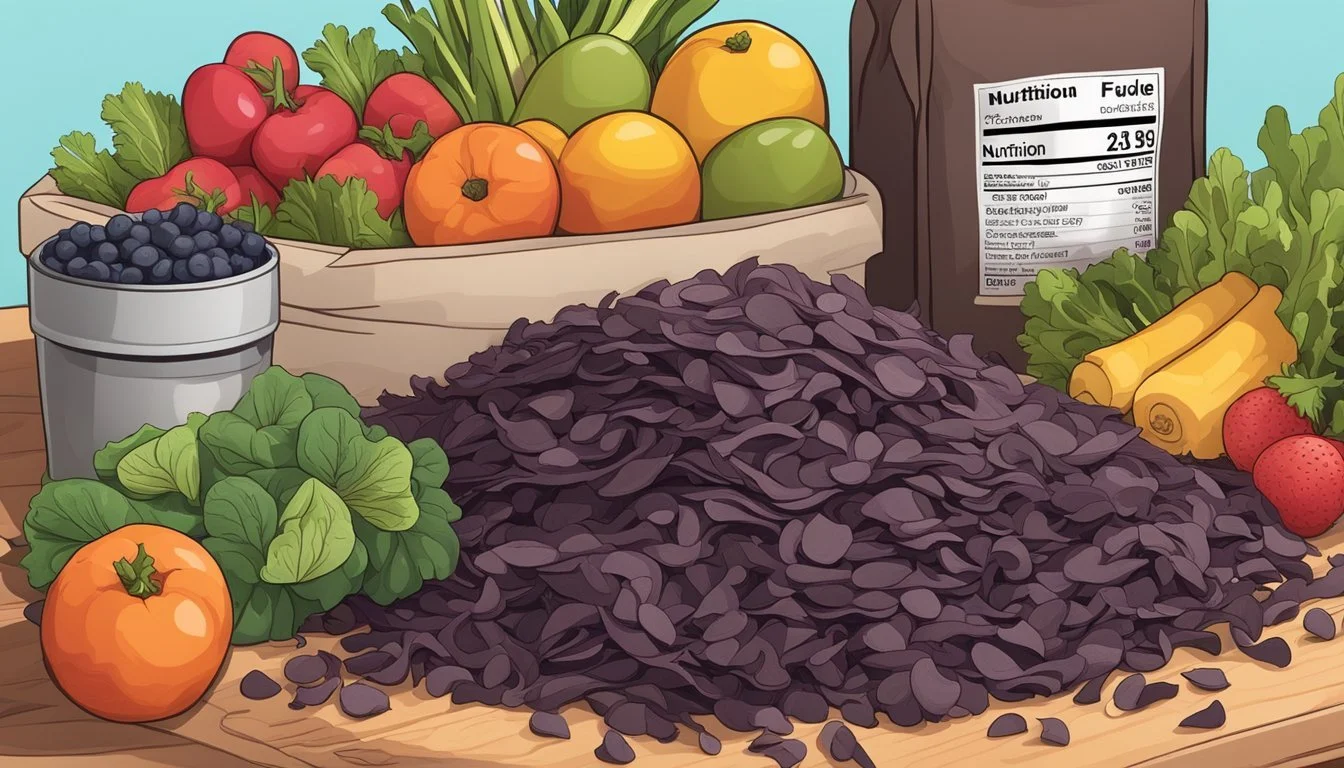Does Dulse Go Bad?
Shelf Life and Storage Tips
Dulse, an edible seaweed, is highly valued for its unique flavor and impressive nutritional profile. As a sea vegetable, dulse offers a variety of health benefits, including being rich in vitamins, minerals, and antioxidants. Dulse does go bad, especially if not stored properly, which can affect its quality and safety for consumption.
When stored correctly in a dry, airtight container, dulse can last for several months or even longer. The dried seaweed should remain crisp and free from moisture to ensure its longevity. Signs that dulse has gone bad include a change in color, texture, or the presence of mold.
Health enthusiasts often incorporate dulse into their diets due to its nutritional benefits. It's an excellent source of iodine, which is important for thyroid function, along with a range of other vitamins and minerals. Ensuring that dulse is stored properly allows one to continue enjoying these benefits without compromise.
Understanding Dulse
Dulse is a type of red seaweed found in the Atlantic and Pacific Oceans. Known for its rich nutritional profile, it is a prized ingredient in many culinary applications.
What Is Dulse?
Dulse, scientifically known as Palmaria palmata, is a type of edible red seaweed. It thrives on the northern coasts of the Atlantic and Pacific Oceans. This seaweed has been traditionally harvested for centuries, particularly in Ireland and the Atlantic coast of Canada.
Dulse features a leathery texture and a slightly reddish-brown hue. The seaweed is often found in dried form, which extends its shelf life. When dried, it can be stored for up to two years. Fresh dulse, however, has a much shorter shelf life, typically lasting four to five days when refrigerated.
Nutritional Profile
Dulse is highly nutritious and offers several health benefits. It is an excellent source of vitamins and minerals. The seaweed is particularly rich in iodine, essential for thyroid function.
It also contains potassium and iron, supporting healthy blood pressure and red blood cell production. Dulse is a notable source of dietary fiber, aiding digestion, and promoting gut health. Additionally, it is packed with antioxidants, which help combat oxidative stress.
A 56-gram serving of dulse provides roughly:
Protein: 5 grams
Dietary Fiber: 30% of the daily value
Iron: 15% of the daily value
Potassium: 20% of the daily value
Culinary Uses
Dulse is versatile in the kitchen and can be used in various dishes. Its flavor is mildly salty with a smoky undertone, often compared to bacon. This makes it a popular ingredient for adding depth to vegetarian and vegan recipes.
Dulse flakes and powder are common forms used in cooking. They can be sprinkled on salads, soups, and stews for added flavor and nutrition. In some regions, dulse is even used raw as a snack or cooked in recipes akin to how one might use nori or kelp.
Its unique taste and nutritional benefits make it a valuable addition to a well-rounded diet, appealing to both gourmet chefs and home cooks.
Health and Nutritional Benefits
Dulse seaweed boasts a rich nutritional profile and offers numerous health benefits. It is packed with essential vitamins and minerals, supports thyroid health, promotes cardiovascular well-being, aids digestion, and assists with weight management.
Vitamins and Minerals Content
Dulse is a powerhouse of essential nutrients. It contains vitamin C, which is crucial for immune system health and tissue repair. It also provides vitamin B6, aiding brain development and function. Iron in dulse supports healthy blood and oxygen transport.
Moreover, dulse is high in potassium, necessary for numerous cellular functions. It contains antioxidants, which help protect cells from damage. Dietary fiber in dulse also aids in maintaining digestive health.
Iodine and Thyroid Health
Dulse is exceptionally rich in iodine. Iodine is vital for the production of thyroid hormones, which regulate metabolism, growth, and development. One ounce of dulse provides 557% of the daily iodine requirement.
This high iodine content can help prevent thyroid disorders such as hypothyroidism, which can lead to fatigue, weight gain, and mood swings. Including dulse in the diet can ensure adequate iodine intake, supporting overall thyroid health.
Cardiovascular Benefits
The nutrients in dulse contribute to heart health in several ways. Potassium helps lower blood pressure by balancing electrolytes in the body. This reduces the strain on the heart and decreases the risk of heart disease.
Additionally, fiber in dulse aids in reducing cholesterol levels. By helping to manage blood pressure and cholesterol, dulse can help improve overall cardiovascular health and decrease the risk of heart-related issues.
Inflammation and Digestion
Dulse has anti-inflammatory properties, which can help reduce inflammation in the body. Chronic inflammation is linked to various diseases, including arthritis and heart disease.
The fiber in dulse supports a healthy digestive system by promoting regular bowel movements and reducing the risk of constipation. This fiber also serves as a prebiotic, fostering a healthy gut microbiome and enhancing digestion.
Dulse in Diets and Weight Management
Incorporating dulse into a diet can be beneficial for those looking to manage their weight. It is low in calories but high in fiber, which promotes feelings of fullness and reduces overeating.
The nutrients in dulse, such as iron and protein, can help maintain energy levels, assisting with an active lifestyle. The high iodine content can also support a healthy metabolism, making weight management more attainable.
Incorporating Dulse in Meals
Dulse, known for its rich nutrients like potassium, iron, and iodine, can be a versatile addition to various meals. It enhances flavors and provides a nutritious boost, making it a favorite for both chefs and home cooks.
Salads and Soups
Salads: Dulse can be used to add both flavor and nutrition to salads. For instance, raw dulse can be chopped and sprinkled on greens for an added umami flavor and crunch. It pairs well with ingredients like tomatoes, cucumbers, and avocado. Some people also use dulse powder as a seasoning instead of salt to reduce sodium intake.
Soups: Adding dulse to soups enhances not just the taste but also the nutritional profile, offering benefits like vitamin A and calcium. It’s particularly good in miso soups or brothy soups, where it can be added in small pieces or as a powder. It rehydrates quickly, integrating seamlessly into the broth, making every spoonful more nutritious.
Snacks and Seasoning
Snacks: Dulse makes an excellent, nutritious snack. Pan-frying dulse can give it a bacon-like texture, suitable for those looking for plant-based alternatives. It can also be crisped up and used as a topping for popcorn, providing a unique, salty snack with a hint of the sea.
Seasoning: Dulse can serve as a versatile seasoning. Skillet-toasted dulse, crumbled finely, can be sprinkled over various dishes like salads, noodles, and tofu. It's a great way to add flavor without adding extra sodium. Additionally, dulse flakes can be used in recipes for a nutrient boost, aligning well with diverse dishes and enhancing their flavor profile.
Safety and Side Effects
When incorporating dulse into a diet, it's vital to understand potential safety concerns and side effects. The main issues revolve around allergies and interactions, as well as contaminants and toxins.
Allergies and Interactions
Some individuals may experience allergic reactions to dulse. These can include symptoms such as itching, swelling, and digestive distress.
Due to its high iodine content, dulse can interfere with thyroid function, particularly in individuals with thyroid conditions like hypothyroidism.
People with diabetes should consult a dietitian before consuming dulse as it can affect blood sugar levels.
Potential Interactions:
Blood thinners
Thyroid medications
Medications for heart or kidney conditions
Dulse may also interact with medications affecting potassium levels due to its high potassium content.
Contaminants and Toxins
Dulse can absorb heavy metals from its environment, such as arsenic, lead, and mercury. This is a concern for sea vegetables harvested in polluted waters.
Consumption of contaminated dulse can lead to serious health issues. It is essential to purchase dulse from reputable suppliers that test for heavy metals.
Overconsumption of iodine from dulse can cause thyroid dysfunction. The recommended intake is typically around 5 grams per day of dried dulse to avoid excessive iodine.
Consuming moderate amounts helps mitigate the risk of heavy metal buildup and ensures a safer addition to the diet.
Storage and Shelf Life
Proper storage of dulse is key to maintaining its nutrients and prolonging freshness. Fresh dulse and dried or powdered dulse have distinct storage needs and shelf lives.
Fresh Dulse
Fresh dulse, a type of red seaweed, has a short shelf life. It typically stays fresh for four to five days if kept in the refrigerator. To store, wrap the fresh leaves in a damp paper towel and place them in a resealable plastic bag. This helps retain moisture and prevent wilting.
Ensure the fridge temperature is set at or below 40°F (4°C). If exposed to air or not kept at the right temperature, the fresh dulse can spoil quickly. Utilizing the freshest dulse ensures the highest iodine and nutrient content.
Dried and Powdered Dulse
Dried and powdered dulse lasts significantly longer than fresh. When stored properly in a cool, dry place away from direct sunlight, dried whole leaf or granules can maintain their quality for up to two years. It is crucial to keep the dried dulse in an airtight container to prevent moisture exposure, which can lead to spoilage.
For even longer storage, some choose to freeze dried dulse. When freezing, ensure it is sealed well to avoid moisture accumulation. This can extend its shelf life to up to two years. Dried versions retain most of their nutrients and iodine, making them a convenient option for long-term storage.





